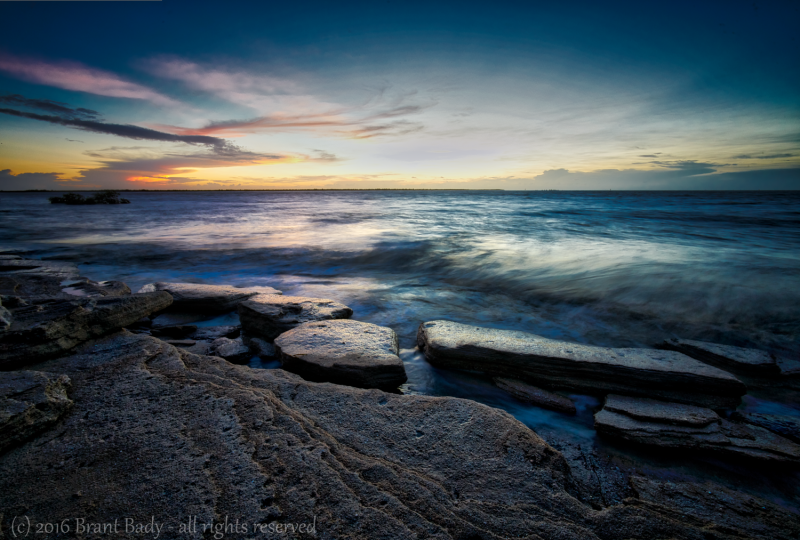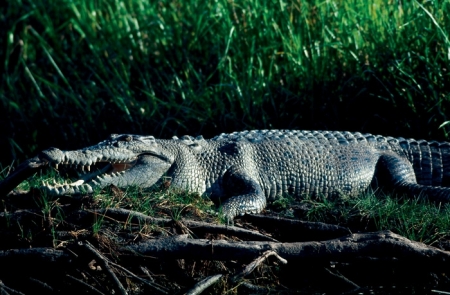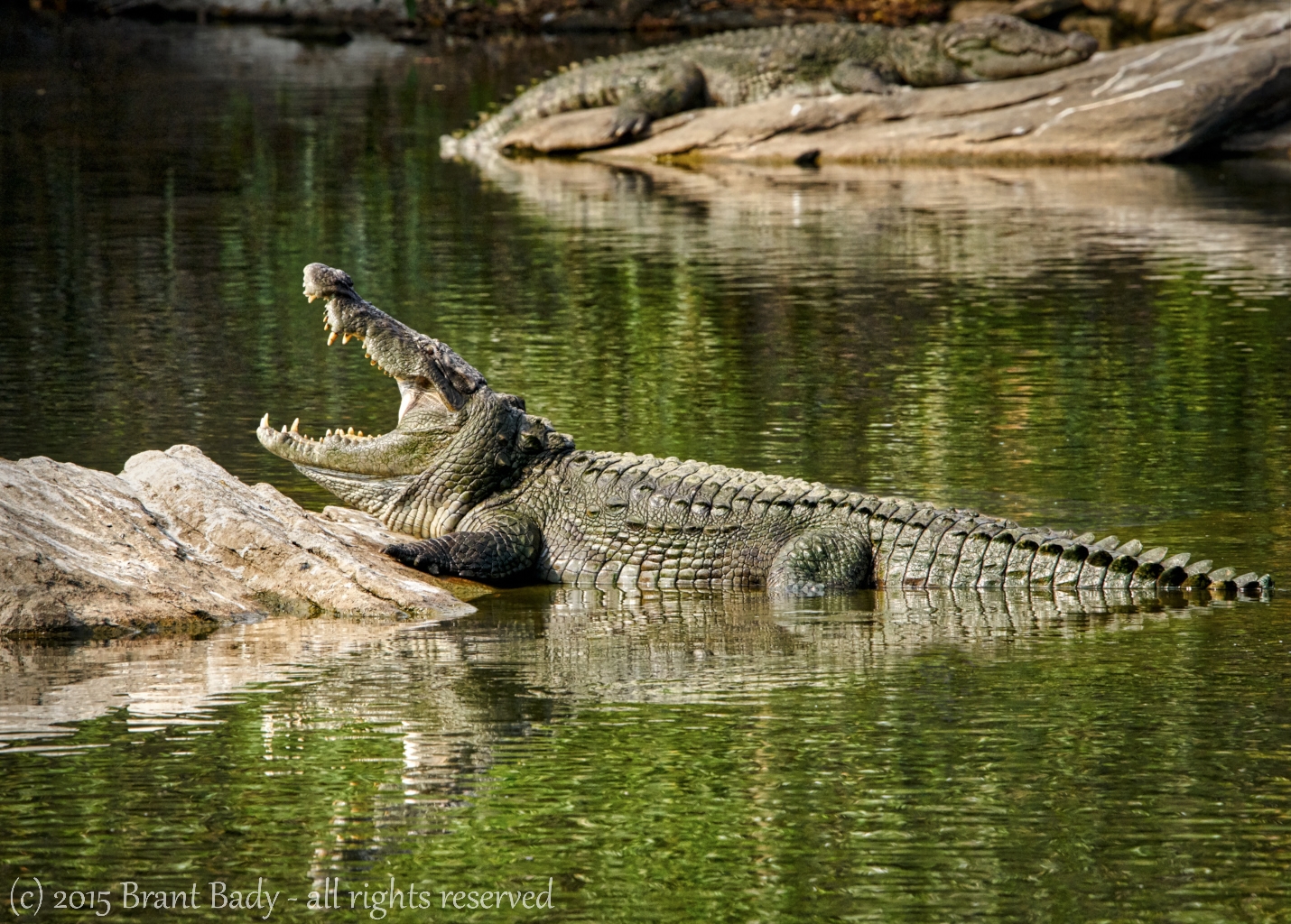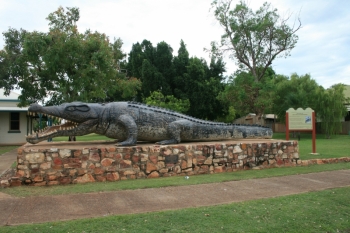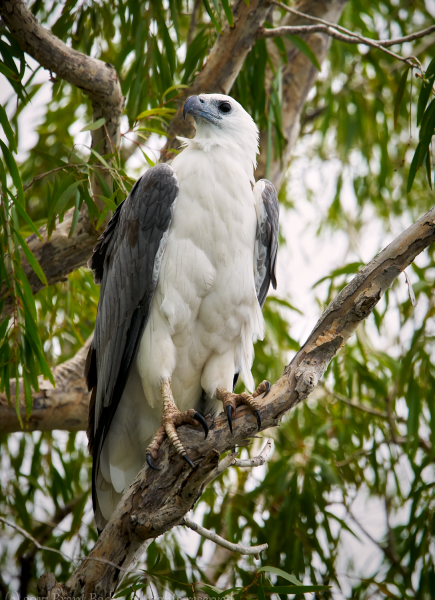Sunset in Karumba – the only difficult part with this shot was to concentrate on the composition, while avoiding getting any of the “Beware of Crocodile” signs that are posted all along the beach into the image, and of course also keeping a tiny bit of a careful eye open for things that bite.
DISCLAIMER – no honeybadgers were bitten or eaten by crocs in the effort to compile this account.
Australia… it’s a land of exotic and unique creatures, many of which that can kill you: stinging box jellyfish, poisonous snakes and spiders and equally poisonous tiny octopus, big red kangaroos and even birds like the Cassowary (the most dangerous bird on earth) that can slice you in half with a single kick, not to mention the two apex predators – great white sharks, and saltwater crocodiles (btw crocs have the strongest bite pressure of any animal in the world – no one has measured the bite pressure of a Great White).
What an opportunity for adventure, the question is how to plan to pull it off?
As a photographer, I invariably find packaged tours organized by tour companies to be abysmal failures because I find the timing to be poor (best light is in the morning before 10 am, or in the late afternoon after 3 pm depending on the latitude), and awkwardly organized in terms of stops that are often just convenient for the tour company and their route. With a few notable exceptions, I have found that its much better to figure things out on my own, with some advance research required to gain insight from other’s local knowledge.
Photo Credit: Tourism NT
Timing is Everything
As evidence, compare the photo above from Tourism NT with this photograph below that I took of a Mugger Crocodile in India, and where I had control over the lighting through selecting the time of day, the angle, and having enough time to capture the moment..
My recent trip to Australia was no exception regarding DIY versus prepackaged, and where in fact I actually found value. Basically I drove around half the country on my own, according to my own whims, schedule, and interest. It mostly paid off in terms of ability to see and photograph things because I could be completely opportunistic… for example, I was ahead of my driving schedule one day, so I did a quick search to find out what else was interesting in the area, and found a place where I could observe duck bill platypus’ and I was in luck, and got some decent shots.
At the top of my list, in no particular order was to dive the Great Barrier Reef, go cage diving with Great White Sharks, and see some crocs in the wild.
Crocs are common at the top end of the continent, in Queensland, Western Australia, and the Northern Territories. After doing a number of dives on the Great Barrier Reef in the Cairns/Mackay area, I started to get the idea that hunting for crocs would be my next big activity, and some of the acquaintances I had made were feeding me a few tips about possible places I could observe them, and some warnings as well. Just driving along the highway there were rivers where “Beware of Crocs” signs were posted, with specific instructions NOT to clean fish by the river, NOT to stand near the edge, and of course NOT to go swimming.
Photo: Tourism NT
Anecdotally, I head a story from a local guide about two women who decided to go swimming in a croc infested area – despite being explicitly warned – and one was taken.. she had enough time to say “ohh, I think a croc has got me” before she was pulled under via a classic death roll. In fact it wasn’t just a “story” – I checked the online register of annual fatalities due to crocs in Australia, and it was clearly listed – actually the only kill for that year listed.
Having a very long telephoto lens, I could do my own croc hunting from a relatively safe distance from the water’s edge. Crocs are ambush predators, and are very opportunistic as well. They will see you long before you will see them, and even if you are standing on a raised dock at the water’s edge it can be dangerous because their primary attack mode is to lunge. Crocs can also move reasonably fast on land if its flat – being capable of short bursts of up to 24 to 29 km / hr.
Aye Karumba – Not just a cheesy line from a western movie involving Mexico
My first miss was in Karumba, Queensland. Karumba is noted for its spectacular sunsets looking out onto the Gulf of Carpentaria as you can see from the header image at the top of this post, but its also a popular fishing destination in the right season. I had emailed ahead to a couple of boats who offer croc spotting tours, but they weren’t in operation in that particular time of year I was visiting (Dec./Jan). It also looked a bit dubious in terms of photo opportunities as it sounded like mostly spotting croc eyes at night using lamps. I had booked a motel for two nights there, and when I checked in I asked the motel manager about any croc spotting opportunities.. she started laughing, because the just the day before I could have had a front row seat with a lounge chair and a cold drink right at the motel. In the yard beside the motel, a 3.5 meter croc was spotted running around, and was in fact corralled by using a wall of green garbage containers and guided to where it could be safely captured and re-located. It made the news world wide.
Credit: Lauren and Toby (surname withheld)
Damn, missed it by one day!
On the Trail of a Monster Croc
The motel manager said that it was perhaps “possible”, if one was lucky, to sight a croc back at Normanton (about an hours drive south, and which I had drove through on the way to Karumba). She said that a VERY BIG ONE had been spotted over the last few years (estimated to be 8 meters or 30 ft long) in the river, and that the best vantage point was from the old bridge that parallels the new one that the highway uses. She was also nice to give me some safety tips, notably that if being chased by a croc, try to zig zag as crocs cannot turn sideways too easily.
Normanton is actually rather famous for a large croc. Back in 1957, when crocs of 8 meters or longer were not uncommon, a woman shot one that measured out 8.64 meters long (the largest ever taken on record). A life size, true-to-scale replica of that croc was carved out of wood and put on display in the town. Nicknamed Krys after the woman who shot it, it can still be seen in Normanton today.
Photo Credit: Kris Hamilton
Stupid is as Stupid Does
Determined to come up with my own do-it-yourself croc hunting expedition, I headed off to Normanton the next afternoon to see if I could sight any wild crocs. The old bridge was easy to find and get to, and I started talking to the aboriginal people who were fishing off the bridge. They were both quite friendly and very interesting to chat with. They confirmed that there was a “big one” who came by often, but hadn’t been seen for a few days. One of the guys said that it wouldn’t like likely to see it until later in the afternoon when the tide came in and up the river (large crocs, like most apex predators, are loath to expend energy unnecessarily, so they are happy to drift up and down the river at the easiest times, and they do tend to feed more at night).
I continued to scan the river while chatting with the locals for a while, but eventually I decided to take a look around the river banks. The far side of the bridge looked more suitable as it had a bit of a slope to its bank, and their wasn’t much in terms of brush, so I wasn’t likely to accidentally trip over a snoozing croc. I set off with my camera and longest zoom lens, and it wasn’t particularly difficult terrain. I did make sure to stay about 20 ft from the actual edge of the water, walking along the top of the riverbank perpendicular to the river. Even if the monster 8 meter present day saurian wasn’t around, a smaller cousin would be worthwhile to spot and photograph, and I was comfortable with having a 20 ft headstart/buffer zone from the water.
All was going well until I hit a patch of mud in among some trees, the overhead foliage allowed the mud to stay wet and slippery. My feet slid right out from under me, I landed on butt, and knocked the back of my head. Not quite seeing stars, but completely embarrassed and having much chagrin, I managed to get up on my feet and backtracked my way back to the bridge. I was covered in mud, no big deal, but alas so was my camera as well. I immediately started to clean my gear and myself up. The locals were a bit amused when I explained I had slipped in the mud, and were happy to let me know that I was lucky I hadn’t fallen into the river accidentally.
If the truth be told I was far enough away from the slope to get ample notice of anything coming out of the water, and I was on the flat summit of the bank and walking perpendicular to the river so there was little danger of me sliding in, so I didn’t think it was particularly risky. But, they know better than me, and after some conversation with them about people being taken when swimming, and their opinion was that it wasn’t the brightest thing to wandering around the riverbank, I demurred to their local and cultural knowledge. That was the end of my croc hunting for that day, as it took me hours to get all the mud off my camera gear, and it put a bit of a damper on my do-it-yourself plan.
Round Two
My next Australian croc hunting opportunity was on the other side of the top of the continent, near Darwin. One of the rivers outside of Darwin is famous for it’s jumping crocodile tours, whereby the crocs are enticed by hunks of meat held above the water to jump out an grab it. This held no interest for me, as I don’t think animals should be exploited for entertainment show purposes. It do think its fine though to observe them in their natural habitat, doing generally natural behaviors.
Against my better instincts about “packaged tours”, I signed up for a rather expensive one day tour from Darwin to Kakadu National Park and back, with the explicit purpose of a boat tour on the Yellow Water Billabong. Note: a billabong is a branch of a river forming a backwater or stagnant pool made by water flowing from the main stream during a flood. The tour also included a few other stops of interest, although none particularly great for photography at the time we were there. Alas, timing is everything, and I was visiting Kakadu in the rainy season, so rather than the crocs being concentrated in shallow or nearly dry river beds and ponds like this…
Photo Credit: Stuart Edwards. (Own work) [GFDL CC-BY-SA-3.0 or CC BY-SA 1.0, via Wikimedia Commons
Instead in the season I was touring around they have hectares of flooded plains to cruise around. Not much of a hope of spotting a croc at this point and time of the year, but there were a few interesting birds, like sea eagles, and the Comb-crested Jacana
I have to say the tour company (indigenous owned) doing the boating part was great and the guide new his stuff and was quite entertaining. His dad apparently had came to the northern territories, married an aboriginal women, and had made a living hunting crocs. My guide’s advice was to ignore the myth about zig-zagging if being chased by a croc. He has been chased numerous times he said, and his solution for escape is to run like hell in one direction as fast as he can!
After leaving Darwin to continue south toward Uluru (Ayers Rock), and given the time of year (rainy season), it was prudent to check the weather and road forecasts, as the highways can often be flooded due to flash rainstorms etc. making them impassable for hours. I was okay, I didn’t travel any highways that had more than an inch of floodwater. However, on the day after I left Darwin, I had heard that a local man and two women has tried to cross a flooded causeway on foot at Cahills Crossing, near Kakadu. Cars are often washed off this causeway when flash floods hit, and the man was taken while wading by what apparently was a 3.3 meter, 150 kg specimen. As one university professor from the area said
“It can pull you under in less than a second and if you resist or struggle, they’re more likely to do a death roll”
The most unfortunate part of human stupidity around large and dangerous animals who are acting out their natural behaviors is that often the animal will suffer in the aftermath of a tragic incident. In this case the croc was hunted and killed in order to recover the body of the person. I am on the side of the croc, and to throw out an alternative approach, I think the government of India has the right idea regarding man eating tigers. If someone is taken the government tends to compensates the family, but the tiger isn’t necessarily killed, although it might be relocated. As one Park Ranger explained, “you know in India, we have many many people, but not so many tigers”.
What did I learn?
- On average, 1 person a year dies from a crocodile attack in Australia
- I should not have wandered down the bank alone, in my defense I studied the guidelines and protocols and checked into croc behavior, and where I was was i.e. higher than 2 meters, at which it is apparently safe to camp… However the alternative scenario. unlikely but possible, is that I could have slipped down to the water somehow. If had trouble getting up a bank, or wound up doing lots of splashing.. it would have been like ringing a dinner gong if a croc was in perception distance, and hungry, I would have been an easy snack.. no shit, its something you didn’t plan for that is likely to kill you.. and smart honeybadgers tend to live longer..
What I should have done?
- I should have hired a couple of the young guys who were fishing on the bridge, to come along and keep me from doing something dumb, and to get a better chance & experience of spotting something.
- Better yet, I should have hung around for longer and possibly hired a boat to go hunt for that elusive but huge croc in order to get some good photographs. The question is what size and kind of boat would be appropriate? “Tinnies” is the slang for small aluminum boats that are popular and found everywhere. Its rare, but it does happen.. where a tinnie gets attacked by a croc. However with an 8 meter croc, what size of boat would be safe? In the Hollywood movie “Jaws”, when Sheriff Brody gets the first clear sight of just how large the shark is, his line is “You better get a bigger boat”…. ha ha good advice to stay in separate worlds of land/air versus ocean! I can say that because I have been in the water in direct contact with another apex predator previously, in my case a juvenile Orca in captivity, and even though it was only playing with me, it quickly got out of hand.. no chance for me if it had actually had any bad intent or instincts towards me.
For Public Service Announcements – I would point you at the following Croc Safety Guidelines & Protocols
- The is the guide for residents, visitors etc.
- This is the Field Researcher protocol for Croc Safety – also good for wildlife photographers I reckon.
The amusing excerpt below is a parody from aforementioned link Field Researcher version:
Distributed by Crocodilian Benevolent Association. Support your aquatic food chain — be a prey item!
- Be oblivious
- Say Wha? There are crocs here???
- Don’t be informed
- Ignore or do not seek information about crocodiles.
- Be in-attentive
- Do not pay attention to your surroundings, ignore that swirl in the water, its probably a fish or an old log
- Be complacent
- “There are crocs here? So what? they never hurt anyone.”
- Be predictable
- “Yep. 5pm, time for cocktails again in the river pool.”
- Be negligent
- Send that undergrad assistant back into the water to recover the pen you dropped, and while she is in there, have her grab a couple of those hatchlings so we can take a photo
- Swim at night – “Whoohoo moonlight skinny dip -last one in is a rotten —-!”

